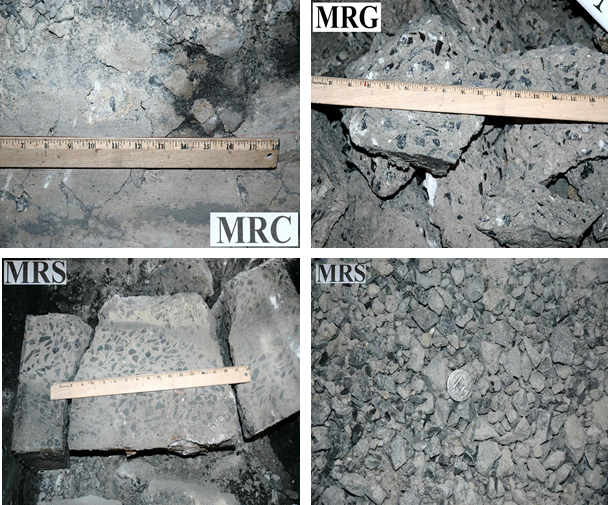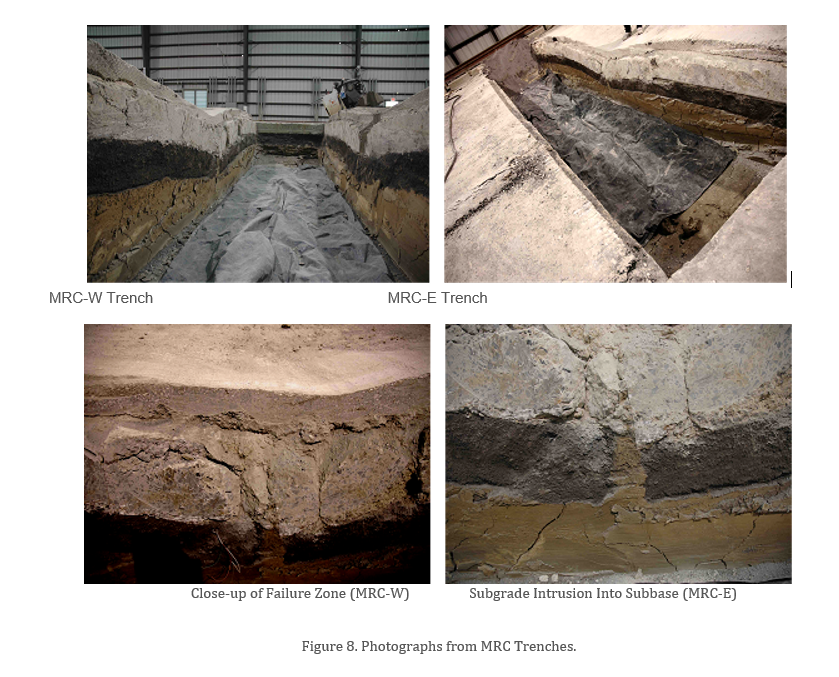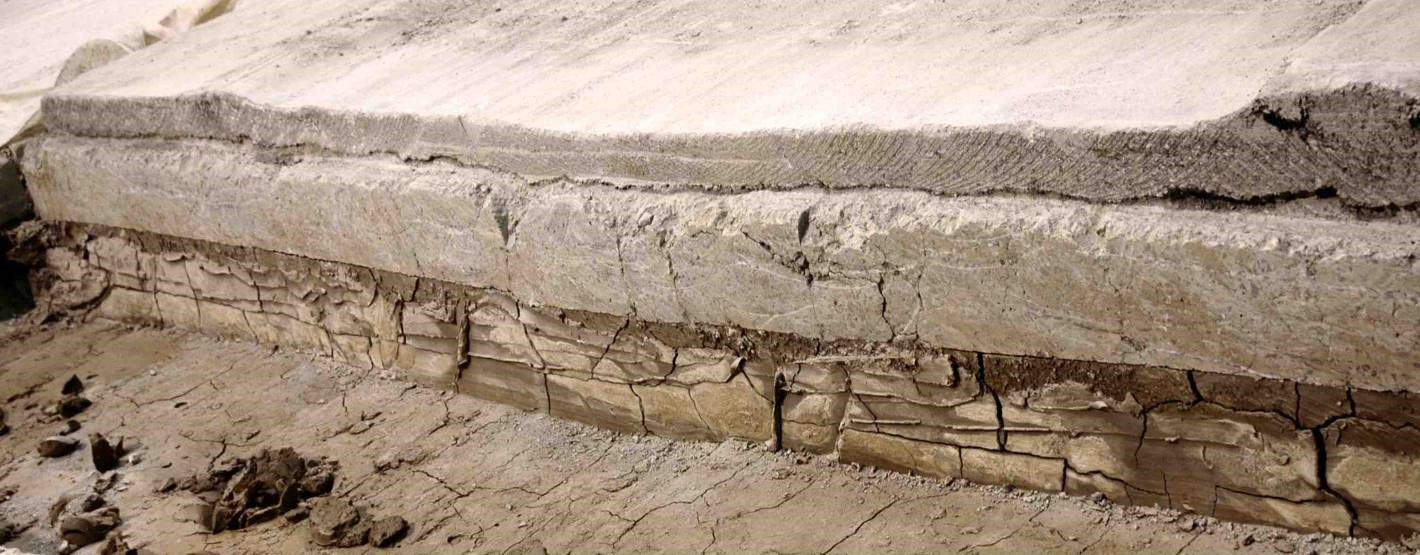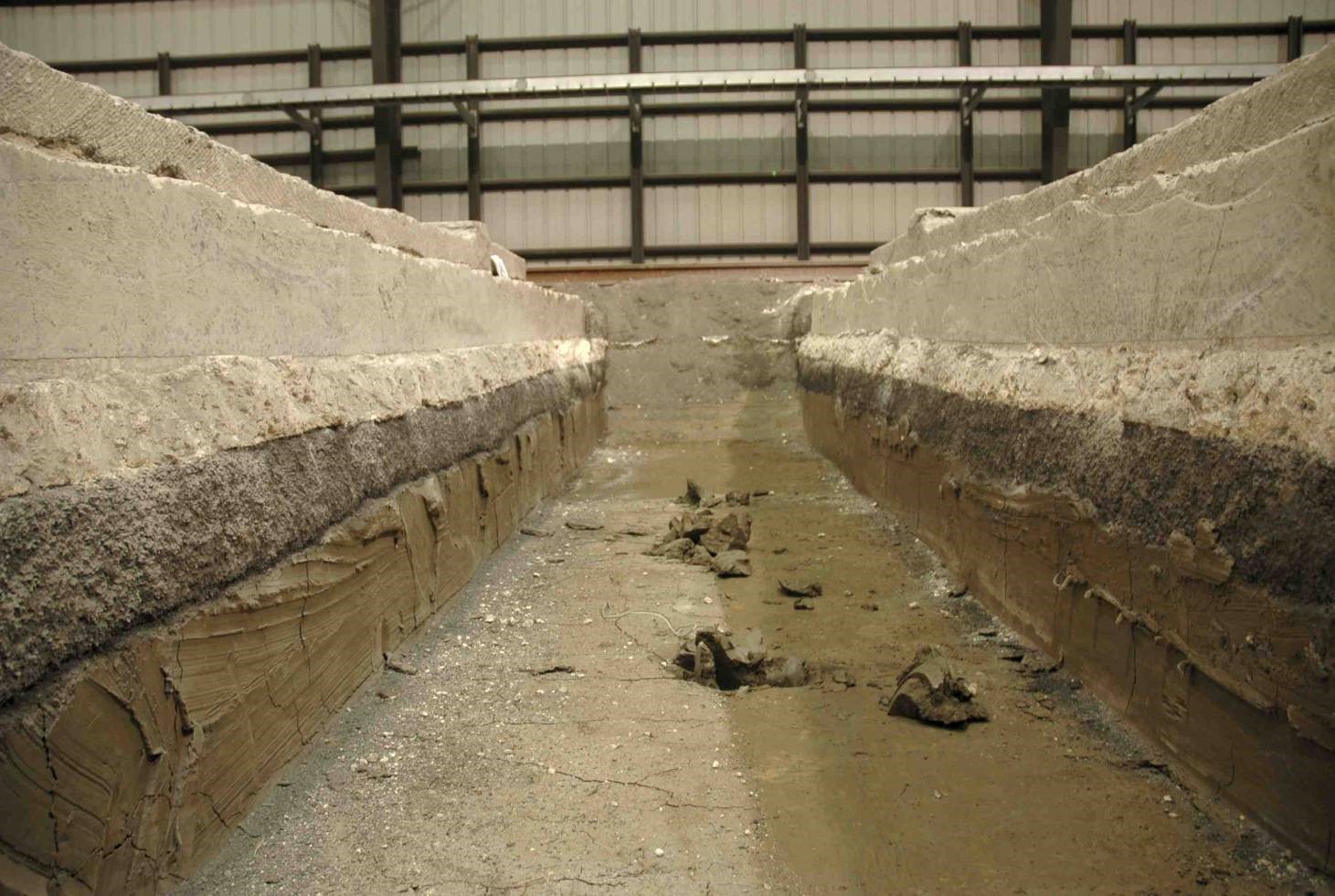Trenching
Four trenches were dug in the rubblized test items perpendicular to the centerline of test items MRC (two trenches), MRG (one trench), and MRS (one trench) at the locations of rut depth measurements on the test pavements. The locations of the test items and the trenches were as follows:
|
TEST ITEM
|
TRENCH
|
START
STATION (feet)
|
END
STATION (feet)
|
|
MRC
|
-
|
325
|
400
|
|
MRC
|
MRC-W
|
354
|
364
|
|
MRC
|
MRC-E
|
374
|
380
|
|
MRG
|
-
|
425
|
500
|
|
MRG
|
MRG
|
452
|
458
|
|
MRS
|
-
|
525
|
600
|
|
MRS
|
MRS
|
552
|
558
|
The purpose of the trenches was to conduct post-traffic investigation into the failure mechanism of the pavement structure. The trenching involved removal of the P-401 HMA layer, the rubblized concrete layer, the P-209 crushed stone base and P-306 econocrete layer (in MRS), and the P-154 subbase layer (in MRC) to reveal the subgrade interface and subsequent subgrade layers below. After removing the P-401 HMA surface, the rubblized concrete layer was exposed in all four trenches. Plate load tests (AASHTO Designation: T 222-81, 2000) were performed inside and outside the traffic path on the surface of the rubblized concrete layer, and visual observations were made. Removal of the rubblized concrete layer exposed the P-154 surface in the MRC trenches, the subgrade surface in the MRG trench, and the P-306 econocrete subbase surface in the MRS trench. In the MRC trenches, plate load tests, CBR, and sand cone density measurements were taken on the surface of the P-154 layer. In the MRG trench (on the subgrade surface) the tests included CBRs, insitu density measurements (drive cylinder), and plate load. Only the plate load tests were performed on top of the P-306 econocrete layer in the MRS trench. After removing MRC P-154 subbase, CBRs and plate load tests were performed, and density measurements were taken on the subgrade surface. In MRS, P-306 was removed to expose the P-154 subbase surface on which plate load, sand cone, and CBR tests were performed. CBR and plate load tests were performed, and density measurements were taken on the subgrade surface after removal of the P-154 subbase. In all the trenches, CBRs and density measurements were also taken at a depth of 1-foot (305 mm) below the subgrade surface. After completing the test, the trench walls were cleaned to clearly expose the layer interfaces. Measurements of the pavement layer interface profiles were taken relative to a horizontal string line to quantify the contribution of each component layer to the total pavement rutting and upheaval.
After the three test items were rubblized, a 4-foot (1.22 m) long by 4-foot (1.22 m) wide test pit was saw cut in each test item for visual examination of the rubblized concrete (extent of fractures from rubblization process, particle sizes, etc.). Figure 6 shows fracture patterns and particle sizes in test items MRC, MRG, and MRS respectively. In general, the top 2 to 3 inches (5 to 7.6 cm) in all the test items was rubblized into dust and stones with a top particle size of 1 inch (2.54 cm) (Figure 1). The particle size in the bottom 9 inches (22.9 cm) ranged from 4 inches (10.16 cm) to 15 inches (38.1 cm) with larger particle sizes in MRS. The test pits showed that the rubblization process induced cracks/fractures for the entire depth of the slabs and that the cracks were tightly held.

Figure 1. Visual Observations from the Test Pits in Rubblized Test Items
The NE end of MRC was the first area of the rubblized pavements to show signs of failure (Figure 3, 4). This failure was not representative of the structural performance of the test item as a whole because one of the pre-overlay test pits (for subgrade evaluation) was located where the pavement failed. A weakened support system resulted because the replaced subbase aggregate material could not be compacted to the same density as in the original construction. A depression in the pavement surface was observed at this location after about 400 load repetitions. The depression migrated longitudinally towards the east until it was about 15 feet (4.6 m) long, but the structure continued to support the full traffic load until it appeared to be in danger of suffering complete structural collapse at 11,814 passes. The weakened area did not migrate back into the west half of the test item and the declared structural life of MRC-NW of 14,256 passes is believed to be a true representation of the structural performance of the test item. Also, MRC-NW did not appear to be in danger of complete structural collapse as had MRC-NE. Trafficking in MRG and MRS was terminated after 25,608 passes. From visual inspection at the end of trafficking, MRG-N appeared to be suffering from structural upheaval outside the wheel track but MRS-N did not. Figure 8 shows the photographs of trench faces in test item MRC and close-ups of the failure zones. Figures 9 and 10 show photographs of the MRG and MRS trenches respectively.


Figure 9. Photographs from MRG Trench.

Figure 10. Photograph from MRS Trench.
Excluding the top 3 inches (76 mm) of finely rubblized material, the rubblized concrete layer behaved as a tightly interlocked, high-density unbound base. The strength of the rubblized concrete layer is derived from the tight interlock between the rubblized concrete pieces and the confinement provided by the HMA overlay and the support system underneath (subbase and subgrade). This interlock will deteriorate under repeated wheel loads. The rate of deterioration is controlled by various factors. Some of the important ones are as follows:
- magnitude and wander of wheel loads;
- loss of confinement due to fatigue cracks in the HMA overlay layer;
- loss of confinement due to weak support system (underneath the rubblized concrete layer) allowing high vertical deflections in the pavement structure.
- any moisture/water migration from base/subbase into the subgrade.
In test item MRC, the top 3 to 4 inches (76 to 102 mm) of subgrade had reduced strength (CBR 3 to 4) because of moisture migration from the P-154 subbase into the subgrade. This weak layer of subgrade allowed higher vertical deflection in the pavement structure which resulted in a faster rate of deterioration of interlock between the rubblized concrete pieces and ultimate failure of the pavement structure. Figures 6 and 9 (for MRG) and Figures 7 and 10 (for MRS) show the rubblized layer did not experience severe deterioration since the support system and the HMA overlay provided sufficient confinement and allowed limited vertical movement. This resulted in longer pavement structural life. Also, the rubblization process did not induce cracking in the underlying econocrete layer (as observed during the trenching study).
Test Results for CBR & Plate Load Testing
The test results from different pavement layers in the four trenches are summarized in Table 1. One of the significant observations relative to Table 1 was made from the subgrade CBRs in the four trenches. Pre-traffic/pre-overlay measurements of subgrade strength in the test pits showed that water had migrated from the crushed aggregate subbase into the subgrade of MRC and softened the top 3 or so inches of the subgrade. The CBR at the subgrade surface in the MRC test pits was approximately 4, whereas the CBR at 1 foot (30 cm) below the subgrade surface was approximately 6 to 8. The MRG subgrade surface CBR was high (about 11). It was assumed that this was due to water being drawn from the subgrade (since the slabs were directly cast over subgrade) by hydration of the concrete during curing. This phenomenon was not observed in MRC (slab over crushed stone base) or MRS (slab over econocrete subbase). The results from trenches confirmed the observations/measurements from the pre-traffic test pits.
Also, performing any type of strength tests just on the rubblized material is very difficult (if not impossible) because of the nature of the material. In this project, plate load tests were performed on the top of the rubblized layer. Due to severe rutting in MRC, plate load tests could not be performed inside the traffic path.
In test item MRG, the ‘k’ value from the plate load test inside the traffic path was lower (k = 322 pci (87.26 kPa/mm)) than the k value outside the traffic path test (k = 457 pci (123.85 kPa/mm)). The lower k value inside the traffic path could be the result of incipient failure in MRG. In test item MRS, the k value from the plate load test inside the traffic path was higher (k = 780 pci (211.38 kPa/mm)) than the k value outside the traffic path test (k = 579 pci (156.91 kPa/mm)).
Table 1. Summary of Test Results from Trenching Study
|
Test Item
|
Trench ID
|
Layer Type
|
Test Type
|
Test Results
|
|
Inside Traffic Path
|
Outside Traffic Path
|
|
MRC
|
MRC-W
|
Rubblized Concrete
|
Plate Load Test
|
-
|
-
|
|
P-154 Subbase
|
Plate Load Test
|
144 pci
|
92 pci
|
|
CBR
|
35.9
|
33.7
|
|
In-Situ Dry Density
|
122.4 pcf
|
122.1 pcf
|
|
Subgrade Surface
|
Plate Load Test
|
-
|
70 pci
|
|
CBR (MC)
|
5 (33.5%)
|
4 (34.5%)
|
|
In-Situ Dry Density
|
89.4 pcf
|
88.2 pcf
|
|
1-foot Below Subgrade Surface
|
CBR (MC)
|
7 (31.3%)
|
6 (31.6%)
|
|
In-Situ Dry Density
|
93.1 pcf
|
93.2 pcf
|
|
MRC-E
|
Rubblized Concrete
|
Plate Load Test
|
-
|
270 pci
|
|
P-154 Subbase
|
Plate Load Test
|
-
|
87 pci
|
|
CBR
|
-
|
-
|
|
In-Situ Dry Density
|
-
|
-
|
|
Subgrade Surface
|
Plate Load Test
|
-
|
60 pci
|
|
CBR (MC)
|
4 (36.1%)
|
3 (38.5%)
|
|
In-Situ Dry Density
|
89.4 pcf
|
86.8 pcf
|
|
1-foot Below Subgrade Surface
|
CBR (MC)
|
9 (30%)
|
8 (30.7%)
|
|
In-Situ Dry Density
|
91.8 pcf
|
93.5 pcf
|
|
MRG
|
MRG
|
Rubblized Concrete
|
Plate Load Test
|
322 pci
|
457 pci
|
|
Subgrade Surface
|
Plate Load Test
|
106 pci
|
149 pci
|
|
CBR (MC)
|
11 (30.6%)
|
11 (30.5%)
|
|
In-Situ Dry Density
|
91.7 pcf
|
92.9 pcf
|
|
1-foot Below Subgrade Surface
|
CBR (MC)
|
8 (31.5%)
|
8 (31.5%)
|
|
In-Situ Dry Density
|
92.0 pcf
|
91.5 pcf
|
|
MRS
|
MRS
|
Rubblized Concrete
|
Plate Load Test
|
780 pci
|
579 pci
|
|
P-306 Econocrete Subbase
|
Plate Load Test
|
409 pci
|
504 pci
|
|
P-154 Subbase
|
Plate Load Test
|
270 pci
|
202 pci
|
|
CBR
|
-
|
-
|
|
In-Situ Dry Density
|
-
|
-
|
|
Subgrade Surface
|
Plate Load Test
|
171 pci
|
101 pci
|
|
CBR (MC)
|
7 (32%)
|
6 (33.4%)
|
|
In-Situ Dry Density
|
91.3 pcf
|
90.7 pcf
|
|
1-foot Below Subgrade Surface
|
CBR (MC)
|
10 (30.4%)
|
9 (30.2%)
|
|
In-Situ Dry Density
|
90.0 pcf
|
89.7
|
MC – Moisture Content
As Constructed Moisture Content for subgrade – 30.7%.
1 pcf = 16.018 kg/m 3
1 pci = 0.271 kPa/mm
CC2 HMA Overlay Post Traffic Testing
Trenching
CBR
HWD
Plate Loads
Back to CC2 Phase V HMA Overlay